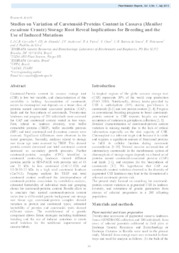Studies on variation of carotenoid-proteins content in Cassava (Manihot esculenta Crantz) storage root reveal implications for breeding and the use of induced mutations.
Studies on variation of carotenoid-proteins content in Cassava (Manihot esculenta Crantz) storage root reveal implications for breeding and the use of induced mutations.
Author(s): CARVALHO, L. J. C. B.; ALMEIDA, J. D. de; ANDERSON, J. V.; VIEIRA, E. A.; CHEN, S.; SOUZA, C. R. B. de; FUHRMANN, E.; SILVA, J. P. da
Summary: Carotenoid-Protein content in cassava storage root (CSR) is low but variable, and characterization of this variability is lacking. Accumulation of carotenoids occurs in chromoplast and depends on a broad class of proteins named carotenoid associated proteins (CAP), lipids and the biosynthesis of carotenoids. Twenty-nine landraces and progeny of 200 individuals were accessed for CAP and carotenoid content varied in two ways. First, related to landrace diversity, total buffer extractable proteins (TBEP), buffer insoluble proteins (BIP) and total carotenoid and ?-carotene content were assessed. Significant differences were observed in the tested genotypes. Secondly, analyses related to storage root tissue age were assessed by TBEP. This showed protein content decreased and total carotenoid content increased as secondary growth proceeds. Further carotenoid-proteins complex (CPC) identified in carotenoid contrasting landraces showed different proteins profile in SDS-PAGE with proteins size of 18 and 33 kDa in low carotenoid (IAC12.829) and 18-20-30-33 kDa in a high total carotenoid landrace (Cas74.1). Progeny analysis for TBEP and total carotenoid content confirmed the interdependence of carotenoid-proteins association by correlation analysis, estimated heritability of individual traits and grouping clones for carotenoid-proteins content. Results allow us to conclude that: natural carotenoid-protein content varies due to differential genetic background and storage root tissue age; carotenoid-protein complex showed variation in protein and carotenoid types; estimated heritability of proteins and carotenoids traits showed different values. The establishment of a genetic component allows future strategies including traditional breeding and the use of induced mutations to create novel variation for the nutritional improvement of cassava tubers.
Publication year: 2013
Types of publication: Journal article
Keywords: Manihot esculenta Crantz, cassava
Observation
Some of Embrapa's publications are published as ePub files. To read them, use or download one of the following free software options to your computer or mobile device. Android: Google Play Books; IOS: iBooks; Windows and Linux: Calibre.
Access other publications
Access the Agricultural Research Database (BDPA) to consult Embrapa's full library collection and records.
Visit Embrapa Bookstore to purchase books and other publications sold by Embrapa.

